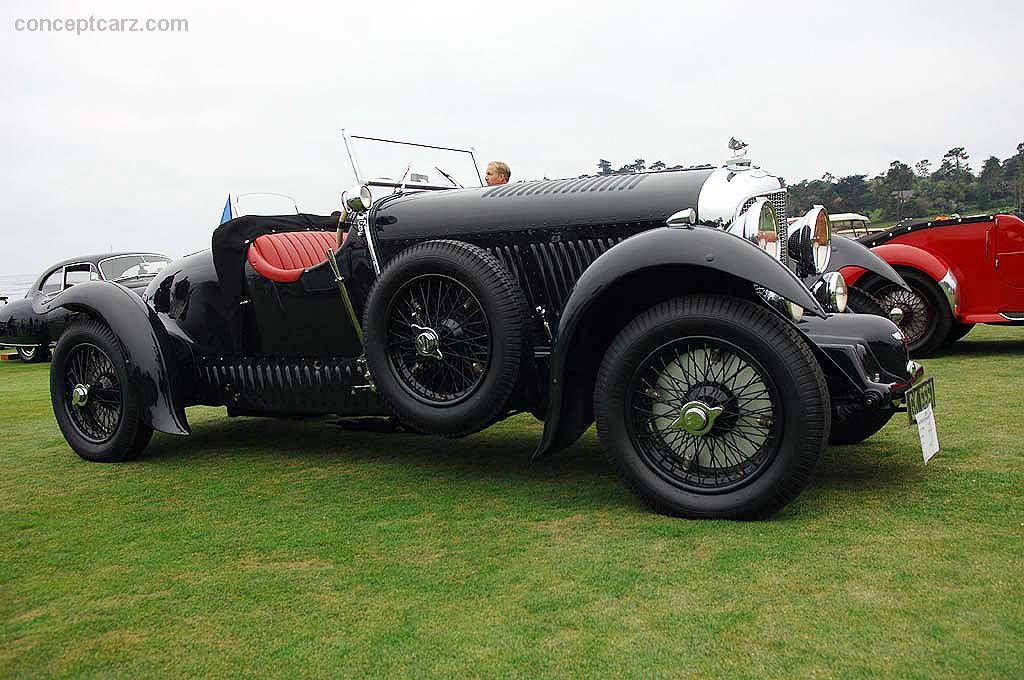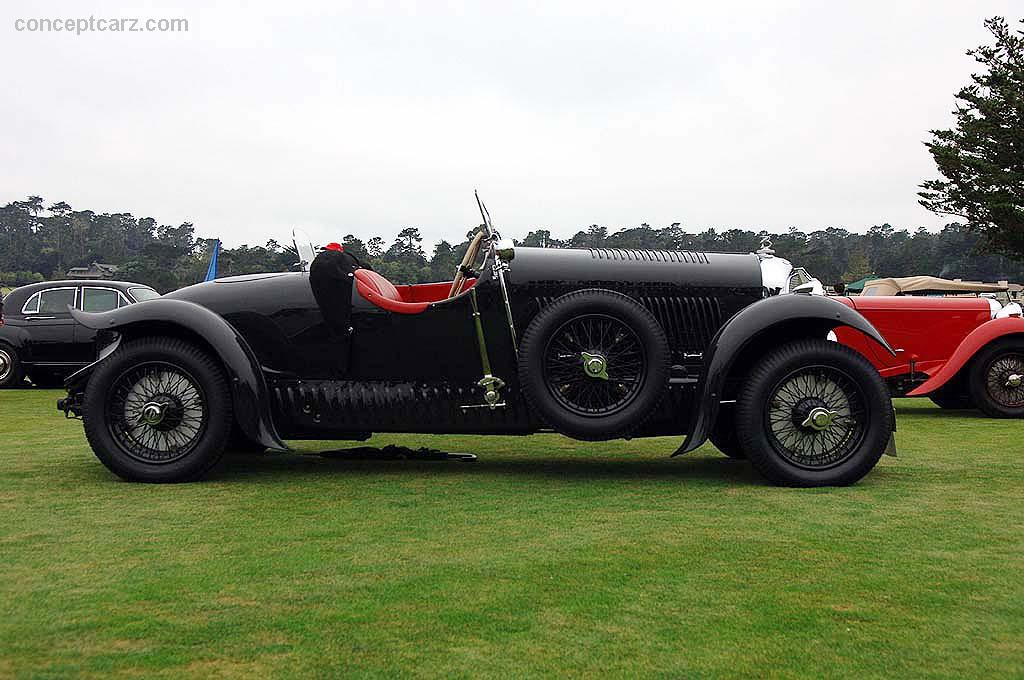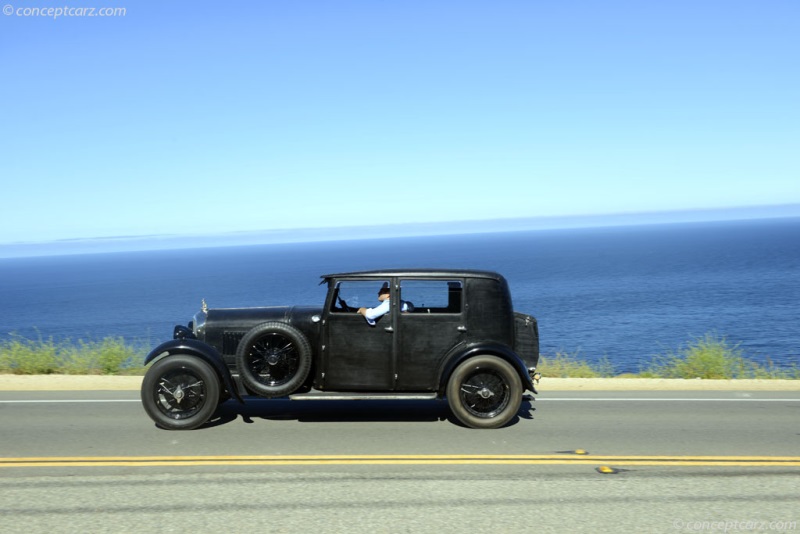The Bentley 3 Litre model won the 24 Hours of Le Mans in 1924 and the 3 Litre Speed model in 1927. It had been proudly introduced by founder W.O. Bentley in 1919 on Stand 126 at the Olympia Motor Exhibition. This model, in mildly developed form with its classic radiator design, British Racing Green livery, and leather-strapped bonnet would become legendary in motor racing history. Among the accolades achieved was a second, fourth and fifth place finish in the 1922 Isle of Man Tourist Trophy earning the Team Prize. 
Drophead Coupe by Gurney Nutting
Chassis #: GK 6661
View info and historyWhen it came time to replace the aging 3 Litre model, Bentley did so with the 4½ Litre. The company had introduced a 6½ Litre model in 1926 which used a larger chassis than the 3 Liter paired with an inline-6 cylinder engine with a 6,597cc displacement (6.5-liter). The 4½ Litre model that followed in 1927 essentially combined the chassis of the 3 Litre and a four-cylinder version of the 6.5-liter engine. It is believed that the first prototype engine was installed into a 3-liter chassis (the 1927 Le Man's practice car) and was later fitted to the first production 4½-liter chassis for that year's Grand Prix d'Endurance at the Circuit de la Sarthe. Nicknamed by the team 'Old Mother Gun,' it was driven by Frank Clement and Leslie Callingham who set the fastest lap of 73.41 mph before retiring early due to the infamous 'White House Crash' pile-up. Woolf Barnato and Bernard Rubin drove a 4½-Litre to victory at LeMans in 1928, the first of three wins by Barnato in the 4½-Litre. Production continued through 1931 with a total of 720 examples (possibly 733) constructed including 55 cars with a supercharged engine, commonly known as the Blower Bentley. 
Drophead Coupe by Gurney Nutting
Chassis #: GK 6661
View info and historyThe engine used features of the original four-cylinder engine along with some from the later 6-cylinder on which development had begun in 1926. Its bore measured 100mm and stroke at 140mm resulting in a displacement size of 4,398cc (268.4 CID / 4.5-liters). The water-cooled, single-overhead-cam, cast iron four-cylinder unit with four valves per cylinder, two SU carburetors, five main bearing crankshaft, and dual ignition with Bosch magnetos, it developed 110 horsepower at 4,000 RPM. Like the 3-Litre, the camshaft was operated by bevel gears on a vertical shaft at the front of the engine. During its production lifespan through the takeover by Rolls-Royce in 1931, few modifications to the engine were deemed necessary attesting to its overall excellent design. The engine was paired with a four-speed manual transmission and the chassis consists of channel-steel, front and rear suspension by semi-elliptic leaf springs, and 4-wheel 17-inch drum brakes finned for improved cooling. The standard chassis had a 130-inch wheelbase size and eight examples were given a short, 1175-inch platform. Over twenty percent of the 4½ Litre received coachwork by Vanden Plas. Additional coachbuilders included Gurney Nutting, Harrison, Freestone & Webb, Thrupp and Maberly, Salmon & Sons, and Weymann.The 4½ Litre Blower
W.O. Bentley was a purist and refused to attach a supercharger to his 4½ Litre model. At Sir Henry 'Tim' Birkin's insistence, engineer Amherst Villiers applied a Roots-Type supercharger to the engine, extracting even more performance from the 4.5-liter engine. It was placed in front of the radiator and at the end of the crankshaft which added weight to the front and increased understeer. More than just the adoption of a supercharger, the engine received special pistons, crankshaft, and lubrication system. The road-going touring versions delivered 175 horsepower at 3,500 RPM and in racing guise, output was measured at 240 bhp at 4,200 RPM. This meant it was more potent that its 6½ Litre sibling.
Drophead Coupe by Gurney Nutting
Chassis #: GK 6661
View info and historyDuring the first year the company contested Le Mans, the 3 Litre of Frank Clement and John Duff was delayed by stones that damaged a headlight and punctured the fuel tank. With the Bentley damaged, the Chenard-Walckers of René Léonard / André Lagache and Christian Dauvergne / Raoul Bachmann finished the 1923 Le Man's race in 1st and 2nd. Applying this knowledge forward, the 4½ Litre and the Blower models were given a guard to protect the pair of carburetors located at the compressor intake, and similar protection for the fuel tank. The first twenty-five Blower cars were given smooth-cased 'blowers' and chassis numbers beginning with 'SM.' The subsequent 25 chassis numbers began with 'MS' and had ribbed blowers to aid cooling.
by Daniel Vaughan | Dec 2022

Drophead Coupe by Gurney Nutting
Chassis #: GK 6661
View info and history

Drophead Coupe by Gurney Nutting
Chassis #: GK 6661
View info and history
W.O. Bentley was a purist and refused to attach a supercharger to his 4½ Litre model. At Sir Henry 'Tim' Birkin's insistence, engineer Amherst Villiers applied a Roots-Type supercharger to the engine, extracting even more performance from the 4.5-liter engine. It was placed in front of the radiator and at the end of the crankshaft which added weight to the front and increased understeer. More than just the adoption of a supercharger, the engine received special pistons, crankshaft, and lubrication system. The road-going touring versions delivered 175 horsepower at 3,500 RPM and in racing guise, output was measured at 240 bhp at 4,200 RPM. This meant it was more potent that its 6½ Litre sibling.

Drophead Coupe by Gurney Nutting
Chassis #: GK 6661
View info and history
by Daniel Vaughan | Dec 2022
Related Reading : Bentley 4½ Litre History
The Bentley 4 12 liter came into existence to fill a void left by the 3-liter and the 6.5-liter variants. The 3-liter suffered from underperformance while the 6.5-liter was unsafe for the roads. The 6.5-liter was powerful, and with poor road-conditions often caused tires to fail quickly. The solution was the Bentley 4.5-liter a vehicle that had enough power to carry the vehicle down the road at....
Continue Reading >>
Continue Reading >>
Bentley
Similar Automakers
Similarly Sized Vehicles
from 1930
1930 Bentley 4.5 Litre Vehicle Profiles
Recent Vehicle Additions
Performance and Specification Comparison
4½ Litre Specification Comparison by Year
Year
Production
Wheelbase
Engine
Prices
Related Automotive News

ICONIC BLOWER BENTLEYS PRIMED FOR MILLE MIGLIA CHALLENGE
Famous, supercharged Bentleys set for 1,000 mile Italian epic
Bentley Boy Tim Birkins 1930 Le Mans racer leads charge
Original Bentley Motors demonstrator completes team
(Crewe, 14 May 2013) Bentley Motors will compete in this years Mille Mi...

Iconic Speed Six to be born again
Bentley announces Speed Six Continuation Series
12 new Speed Six models to be handcrafted by Mulliner, the oldest coachbuilder in the world
Identical recreations of the cars that won Le Mans in 1929 and 1930
Follows huge success of 12-car Blower...

The Cars That Established The Bentley Legend, Coming To Concours Of Elegance
Concours of Elegance 2019 will celebrate Bentleys Centenary in style, with a collection of the cars that established the Bentley legend
Bentleys reputation for racing excellence is exemplified by a display of the first Bentley to race at Le Mans,...

BENTLEY AT THE PALACE OF HOLYROODHOUSE CONCOURS OF ELEGANCE
Historical Bentleys star at prestigious Edinburgh event
1952 R-Type Continental, Blue Train and 8 Litre among line up
Bentley Sunday highlights best of British brands historic range
(Crewe, 31 August) Scotlands historical seat of pow...

CLASSIC BENTLEYS READY FOR ACTION-PACKED SUMMER SEASON
Famous heritage models hit international classic show circuit
95 years of history to tour from Goodwood to Pebble Beach
85th anniversary of Blue Train race and 1930 Le Mans win
(Crewe, 21 May 2015) Legendary cars from Bentleys past are...

ICONIC BLOWER BENTLEYS PRIMED FOR MILLE MIGLIA CHALLENGE
Famous, supercharged Bentleys set for 1,000 mile Italian epic
Bentley Boy Tim Birkins 1930 Le Mans racer leads charge
Original Bentley Motors demonstrator completes team
(Crewe, 14 May 2013) Bentley Motors will compete in this years Mille Mi...
































